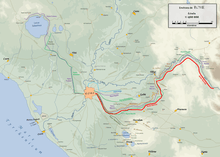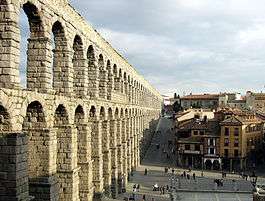Aqua Anio Novus
Aqua Anio Novus (Latin for "New Anio aqueduct") was an ancient Roman aqueduct. Like the Aqua Claudia, it was begun by emperor Caligula in 38 AD[1] and completed in 52 AD by Claudius, who dedicated them both on August 1. Together with the Aqua Anio Vetus, Aqua Marcia and Aqua Claudia, it is regarded as one of the "four great aqueducts of Rome."[2]

Route

Frontinus describes its source as "at the forty-second milestone on the Via Sublacensis in Simbruibe territory, from the Anio River, which flows muddy and turbid even without the bad effect of rain, since it has cultivated and such lands around it, and as a result, quite loose banks".[3] Its flow at the intake was 197,000 cubic metres (7,000,000 cu ft) a day.
The aqueduct was split into two channels above Tivoli and combined again near Gericomo. From its filtering tank near the seventh milestone of the Via Latina it was carried on the arches of the Aqua Claudia, in a channel immediately superposed on the latter. It terminated at a great tank on the Esquiline Hill near the temple of Minerva Medici.
The Aqua Anio Novus was the highest in level of all the aqueducts that came into ancient Rome.
As the water was prone to be turbid, Trajan made use of additional sources from the two uppermost of the three lakes formed by Nero for the adornment of his villa at Subiaco, thus lengthening the aqueduct to 58 miles and 700 paces.[4] The lakes were created by dams in the river, and were the tallest of any built by the Romans. They were swept away by the river in the Medieval period.
It was built of tuff and brick.[5]
Before the reforms, the aqueduct was freely used to supply the deficiencies of other aqueducts and being turbid, rendered them impure. It is described in some detail by Frontinus in his work published in the later first century, De aquaeductu.
See also
References
- Suetonius, Caligula, 20
- Blackman, Deane R. "The Volume of Water Delivered by the Four Great Aqueducts of Rome." Papers of the British School at Rome 46 (1978): 52-72. https://www.jstor.org/stable/40310747.
- Frontinus 2.14
- The length of 62 miles (100 km) given to the original aqueduct in the inscription of Claudius on the Porta Maior is considered to be an error
- Bono, P. and Boni, C. "Water Supply in Rome in Antiquity and Today". Environmental Geology 27 (1996). p. 131
External links
| Wikimedia Commons has media related to Anio Novus. |
